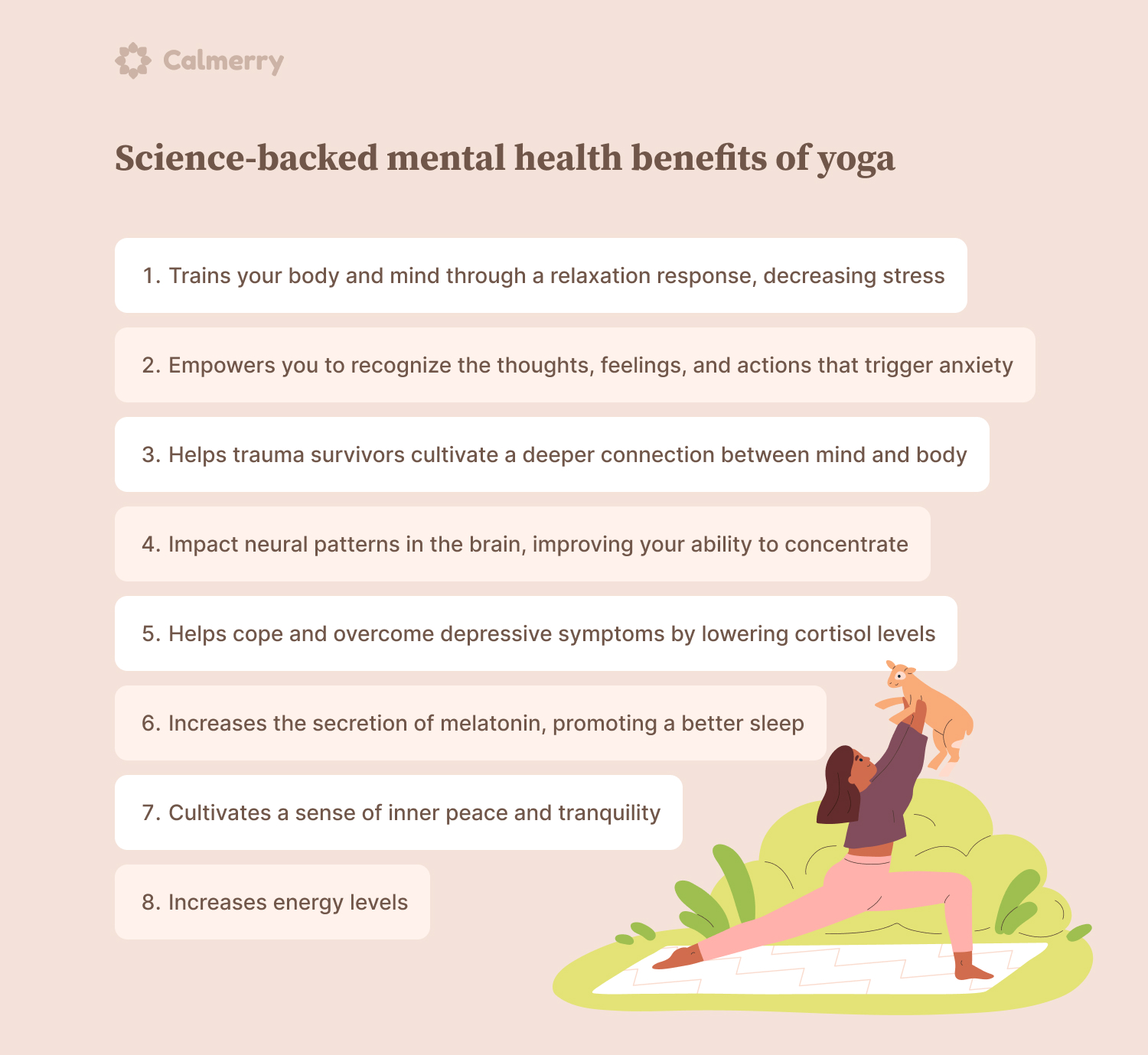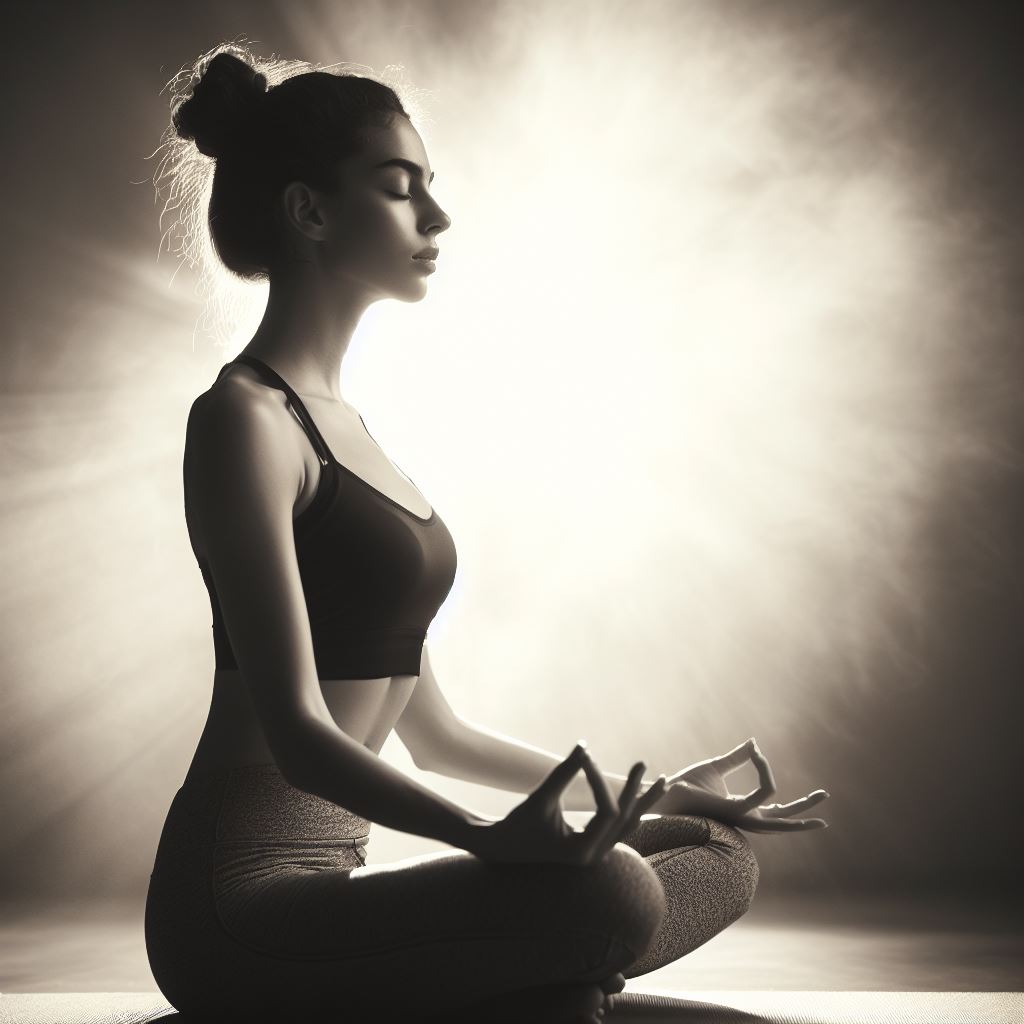Physical Address
304 North Cardinal St.
Dorchester Center, MA 02124
Physical Address
304 North Cardinal St.
Dorchester Center, MA 02124


The yogic physical activity is an ancient one, almost 5000 years old practice. The oldest mention of yoga practice is seen in the text of rig vedas. The reason why this practice still holds relevance in our daily life is because this activity helps us unlock our minds. The mental health benefits of yoga to calm your mind are countless and some of them you can read below.
The mind-body connection is the buzz in the fitness/" title="fitness" data-wpil-keyword-link="linked">fitness industry nowadays. The better mind-body connection you have, the better balance and control you have on yourself. This connection can be strengthened with yoga.
The mind-body connection in yoga can be trained and improved in almost all the asanas. The basic premise of doing yoga is to relax and focus on your bodily actions like breathing and attention to your movements.
The asanas in every level of yoga promotes this connection first then comes whether or not you have the ability to perform that yogic move.
The mind-body connection is the very first tick box in doing yoga, the very first thing before you do any asanas is to clear your mind and get a grip on your body.

Stress by definition is putting yourself through too much workload in a limited time period. The mental stress is not something which can be measured accurately but can be treated and cured well through use of yoga.
The stress is firstly induced mainly because of lack of time and work management skills, which results in total meltdown and causes abrupt chaos in our minds. The second reason why we go through stress is because of the heavy intense exercise/" title="exercise" data-wpil-keyword-link="linked">exercise or physical activity. The first thing we should do is to take our time to grasp the entire situation and prioritize our workflow and that is easier said than done. To help ourselves and reduce stress we can take up a number of solutions but yoga by far is the best one.
The yogic asanas will be effective, time efficient and mainly with no side effects of any kind.
The techniques for any stress reduction while doing yoga is going to be one way or the other very similar, except for the intensity level and mobility of the person doing that asana.
The asanas like Uttanasana, Shavasana and Sukhasana are recommended for anyone looking to reduce stress.
The three main hormones that are responsible for increasing stress levels in our bodies are epinephrine (adrenaline), norepinephrine and cortisol.
Managing the levels of these three hormones is the key to managing stress.
The reduction of and maintenance of these three hormones especially cortisol is achievable with yoga.
Scientists have found the instant reduced levels of epinephrine and with regular yoga cortisol levels also fall back to moderate levels.
The use of modern allopathic medicine may help reduce stress but they may dip their levels even more and low levels of these hormones may also cause lethargy. So for long-term stress management yoga is going to be the best tool.
Anxiety is a feeling of fear and excess worry for almost every activity. In some cases anxiety is the symptom and sometimes it is the problem causing the issue.
If you feel like you are hyperventilating, overthink everything, sweat constantly, hands and legs are shaking all the time, have rapid heart rate, feel tired all the time and struggle to concentrate then you might be suffering from anxiety.
If you wish to get away from anxiety or even try to prevent anxiety coming close to you, yoga will definitely help. Yoga practices have proven to be highly effective to reduce anxiety.
Practicing yoga for anxiety management is the best option for almost everyone. If you suffer from anxiety or get any feeling of an upcoming anxiety attack then these yoga asanas will be effective in combating these feelings.
Kapalbhati pranayama: This yoga practice is the easiest of all. You sit on the floor with an erect spine and put your hands out on your knees, then you start with a deep breathing and exhaling with your eyes closed. Do this for about 2 minutes daily.
Vajrasana: This yoga asana requires you to sit on the floor on your shins, then keep your hands on your thighs likewise and breathe deep and exhale slowly. Doing this for about 2-5 minutes daily relieves shaking of hands and legs. This will help you improve your digestion too.
Tadasana: In this yoga pose you stand straight and lift one of your legs to touch the other leg's knee with its foot. You maintain this balanced position and try to breathe with your hands in a namaste pose. You try to do this for 20-45 seconds.
There are many more advanced yoga asanas like Sarvaangasna, Dhanurasnas if your mobility supports it, but for most people the above mentioned poses are going to be more than enough.
From a scientific standpoint, doing yoga daily reduces stress hormones and increases GABA(gamma aminobutyric acid) and endorphins in our body. The slow and and steady introduction of GABA and endorphins helps fight long term anxiety development and prevents any possibility of a major anxiety attack in the future.

One of the biggest mind degrading diseases known to mankind is depression. With low levels of all good hormones the only natural way to get out of depression is good social company, a well balanced diet, and some small activity, the new way to tackle depression is yoga.
Yoga has proven to be an effective tool to fight against depression and many people are turning to yoga instead of using antidepressants.
Yoga is going to be a better option for someone trying to fight depression.
Most people suffering from depression are likely going to take antidepressants and have articulated therapy sessions and need a ton of help from their family and friends. This entire process is time consuming, requires a lot of planning and has side effects on human health.
The entire process will go smoothly and yield better results if it is complemented with yoga. Yoga will not only help one to get rid of depression faster, it will do it without any need for predisposed appointments or allopathic side effects.
The newer generation is showing an increasing trend in stress and depression related suffering. The high stress lifestyle has increased cortisol and cholesterol levels and reduced dopamine and epinephrine. This case worsens when it evolves into MDD (major depressive disorder).
The MDD patient shows a minimal hypothalamus activity which leads to low levels of essential hormones. This further leads to low appetite which follows with a sodium deficiency which creates newer problems like thyroid on the top of already low levels of dopamine and serotonin.
The practice of yoga hits all the right places when trying to fight against depression. Yogic practices have shown to increase dopamine and reduce cortisol. The MDD patients who are on allopathic treatment and are using antidepressants show only a 50% result improvement. The long treatment does not hit all the right targets when treating depression. Yoga on the other hand has shown to trigger the right hormones, which not only reduces bad hormones but also balances out all the chemical imbalances in the body.
To say the practice of yoga asanas is only for someone who is suffering from a big mental and physical health problem would be an understatement. Yoga can help the healthier body to stay that way and even enhance their emotional spectrum.
Everyone goes through a lot of emotional phases in life and if you don't hold a grip on these emotions they might steer our lives in unwanted directions.
The biggest emotional imbalance happens during puberty stages of lives, most girls get their menstrual cycles started and boys see changes in their voice and physical appearance. These stages also bring a ton of emotional imbalances and unfortunately these are growing years and any loss of control over the emotions can lead to major health issues in future.
The emotional maturity does come in time but till then we must learn to manage it. The best way to do it is with yoga.
The regular practice of yoga will help you control your anger, sadness and help you keep a balanced mindset for your everyday activities.
People who have problems controlling their anger can start pranayama to see instant control of their emotions.
The cramps from periods can lead to cranky behaviors and that can impact negatively, to control this women should do Dhanurasana and Baddha konasana.
The regular yoga practices will increase the dopamine which is a feel good chemical, this helps us to keep our aspirations high and work without getting demotivated.
A case study on adolescents in Himachal Pradesh showed some groundbreaking results on how yoga helps regulate emotions.
The study showed 110 students ranging from age 13 to 18, among those kids 58 didn't practice yoga and 52 students did. The emotional maturity of students who practiced yoga was much higher than others. The improved attention span and grasping ability was observed in students practicing yoga.
The students practicing yoga showed a higher emotional maturity, better concentration and attention span and an overall good self esteem.
Sleep is an important activity for keeping our body healthy, in recent times people have been showing a bad sleep schedule. It is not enough to just get 7-8 hours of sleep, the sleep quality also matters. To improve sleep quality we must improve sleep patterns and yoga can definitely help us here.
Sleeping is not just lying unconscious for hours on end, it's a very complex activity, our brain goes through a minor reset, our toxins get flushed out, the vital organs get a detox and our entire body gets a maintenance check. All these things happen if you go through sleep stages properly.
You might have observed it yourself, if your sleep gets disturbed or is incomplete for some reason the following day becomes a challenge to survive let alone get some work done.
Your sleep is the basic foundation your entire body's hormone production and regulation relies on.
Lack of sleep for a few days leads to crankiness and if this continues then it may lead to delusion and at worse can also lead to full blown mental breakdown in just a few days.
Yoga is a much better tool than sleeping pills to get your sleep cycle on track. The following yoga asanas are the most effective when it comes to correcting your sleep cycle if you are stressed or suffering from some disease or even if you are jet lagged.
Sirsasana: In this asana you do assume a handstand-like position but with extra support of your hands to maintain balance. This helps rush blood in your head and release melatonin.
Pranayama: This is a simple yoga asana, you sit on the floor with your palma on your knees and breath deep and exhale slowly. You can chant “om” if you want to. Doing this for 4-5 minutes before you sleep can drastically improve sleep quality.
Sarvangasana: This ansa requires you to lie down and slowly move your feet above to reach up and you need to hold this position for 1-2 minutes. Sarvangasana relieves the tension in your entire body to prepare the body for a long resting session.
The average sleep experience is a very complex process our body goes through, though this may seem simple enough to someone who isn't an expert in the study of sleep.
Every sleep cycle we go through comes with waves, each wave lasts for about 1.5 to 2 hours depending on each person and we need to go through 5 to 6 of these waves, which adds up to 7 to 9 hours of sleeping time. Now if you somehow miss the first wave you might not feel sleepy for another hour and half.
The tricky thing is to reach the third or fourth wave uninterrupted. In this wave we sleep deeply and some studies suggest we experience dreams in this wave. If we expect to reap all the benefits of sleep we must sleep with intention to go through all the waves without any disturbance. To help us go through these waves effectively yoga can help.
The practice of pranayama yoga can help your body relax and prepare your mind for entering the first wave. The Sirsasana can help your body to regulate melatonin naturally which is a hormone that triggers sleep.
To live life at best you need to have a healthy body and mind, a healthy body and mind is achieved through resilience of body.
The ability of our mind and body to resist a disease, change in environment, change in diet or any change in our comfort zone and still maintain a healthy body and mind function is resilience.
The yogic practices help nurture and grow the body's resilience overtime.
Growing resilience through yoga is not something that can be achieved overnight, some experienced yogis who have practiced yoga for years have achieved it.
The strength training for muscles and antibodies in blood that prevents a particular disease from ever returning are some examples of how resilience in our bodies work.
The advanced yoga asanas which require a prerequisite of mobility and years of experience are the ones that build resilience in our body. Advanced asanas like Bhujangasana, Parivrtta Surya Yantrasana, Kakasana are sure to build resilience in your body.
The general use and benefits of yoga are visible and are backed by science, but the true extent of practicing yoga can be seen in some people's stories.
Joe Dailey was an avid runner and an average fitness enthusiast, after surviving a horrible crash he lost his ability to walk, this took a toll on Joe and the practice of yogic asanas did help him make peace with what happened to him and is now a yoga fitness enthusiast.
Claire Copersino fell into deep depression after her life partner passed away from cancer, her will to live was fading day by day and antidepressants weren't helping. She discovered yoga one day and started practicing different asanas everyday. Slowly and steadily she came out from that depression and is now leading a healthy life and is looking towards the future.
Many people who struggle with thyroid conditions are unable to lose weight and this then again fuels the other hormones like cortisol. With help of yoga many people have experienced weight loss just hy balancing their hormone levels, reducing the cortisol and balancing thyroid can lead to weight loss that no other fitness routine can provide you.
The modern allopathy science has taken us far and has done so much for humanity but still this science is just based on symptoms and treating them. The broader picture is almost never considered in this approach. Yoga on the other hand is all about seeing the bigger picture and solving the problem from the root.
This is what makes yoga so beneficial the approach is holistic and not about isolating the problem. You don't really need to do dozens of asanas for hours to reap the benefits of yoga, you need just a couple of asanas and practicing them just for 15 minutes daily can work both your health and your emotions.
In the history of treatment and health management no other care system works so well in collaboration as well as yoga does.
The yogic asanas do not require you to go on a strict diet or follow a certain routine or even interfere with any other ongoing treatment. Yoga can easily give you an alternative to combat any mental or physical therapy.
The yoga practice is by default side effect free, unlike other allopathic treatment yoga has proven to create no side effects at all. Practicing one asana for health benefits will not only target what the asana is meant for but will also add other mental benefits too.
Yoga is the solution to many problems in our lives, a person who does regular yoga experiences a healthier body and mind. But it has its limitations too.
Yoga is only effective if done correctly and for a long time which for most people becomes difficult at times.
Recognizing what yoga to do for what your needs is not that difficult, but what is difficult is to undermine the flexibility, mobility and strength required to do a particular asana.
Not understanding the levels and going for an advanced stance in yoga can sometimes cause injury.
To avoid all these limitations you need to consult a yoga practitioner and teachers, get professional advice for a better result.
Doing yoga is free and requires no equipment at all. Anyone can do it, children, old people, physically handicapped and also pregnant women. Doing yoga produces no side effects on the body or mind and is a viable long term activity.
Yoga is undoubtedly a better tool to fight poor health, emotional distress, stress, anxiety, and depression.
Yoga will improve your hormonal balance, get your sleep cycle straight, improve emotional response, build immunity and improve overall mental and physical health.
But all of this happens if you start yoga early on, remember yoga won't bring results overnight and doing yoga correctly and with proper guidance is no less important.
So keep in mind start doing yoga early on and with just 20 minutes of yoga asanas you can reach your mental and physical balance and lead a happy life.